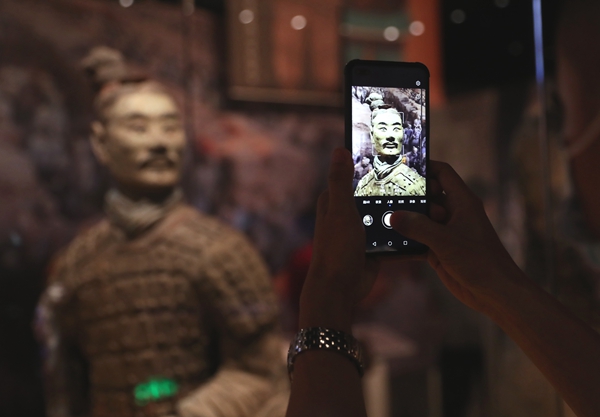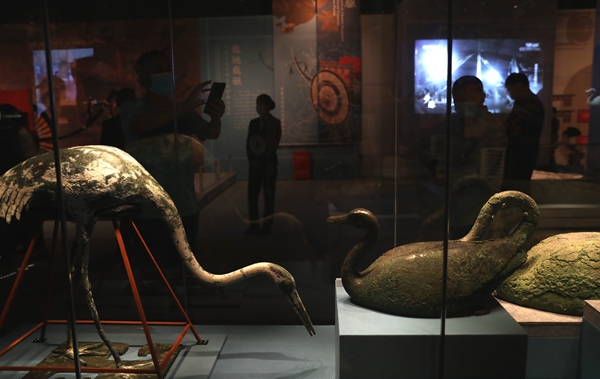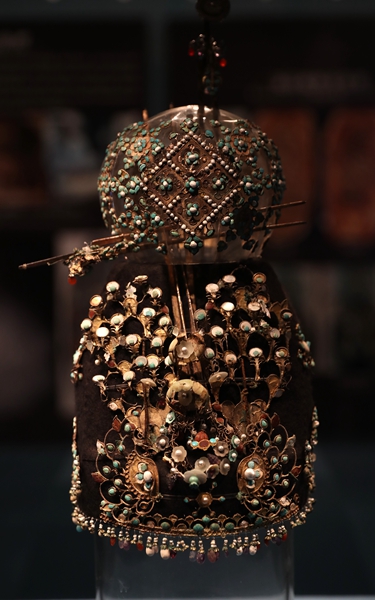
Cultural relics from 23 museums and research institutes are being exhibited at the Capital Museum in Beijing. They include a Terracotta Warrior.[Photo by Zou Hong/China Daily]
Exhibition shows the results of the work and devotion of specialists bringing the past back to life, Wang Kaihao reports.
In many respects, they are often the unsung heroes of exhibitions. The public view the works on display but few consider those that were responsible for putting them there in the first place. If it were not for the devotion of conservators, these artifacts would remain unseen and certainly unappreciated.
From Terracotta Warriors to bronzeware, silk pieces and paintings, the 50-odd cultural relics from 23 museums and research institutes nationwide gathered in a gallery of the Capital Museum in Beijing pay homage to those "cultural relic doctors "who gave them a second life in the public eye.
The three-month exhibition Pursuing Eternity: Conservation of Museum Collections opened to the public on May 18, aptly coinciding with the 45th International Museum Day.
"The reason why these artifacts were selected is not only because they are of high historical value and reflect their time or show extraordinary aesthetics," says Zhou Yang, a researcher from the Hangzhou-based China National Silk Museum in Zhejiang province, the main curator of the exhibition. "These items were selected for this exhibition because they reflect the growing concept and technology of collection conservation."

Cultural relics from 23 museums and research institutes are being exhibited at the Capital Museum in Beijing. They include bronze statues of aquatic birds from the mausoleum of Qinshihuang.[Photo by Zou Hong/China Daily]
A bronze container of gui at the entrance of the gallery is one such example. Dating back to the Western Zhou Dynasty (c. 11th century-771 BC), this Earl of Hao Cuo vessel is just 21 centimeters high. Its diameter is less than 30 cm.
"Its appearance may not be that outstanding," Zhou says. "But it shows how people have pulled together to save it."
This artifact was recorded in a book on antique bronzeware from the Northern Song Dynasty (960-1127). Though greatly admired as a treasure about a millennium ago, its destiny seemed to condemn it to obscurity.
When it was rediscovered in 1978, broken fragments of the precious vessel were nearly processed as waste at a recycling station on the outskirts of Beijing.
But the alarm was raised as piece after piece was retrieved, thanks to people's patience in rummaging amid the waste. The restorers' delicate skills ensured that it was made whole once more and able to be admired. Now, it is in the collection at the Capital Museum.
Other exhibits had similar destinies. In 2001, a Tang Dynasty (618-907) tomb was found on a college campus in Xi'an, Shaanxi province. During that period, of course, it was the national capital Chang'an. The epitaph indicates the tomb's occupant was Li Chui, the fifth-generation granddaughter of Li Yuan, founder of the dynasty. She had died in labor.
A crown still on her remains retained its sheen, but tiny decorative pieces seemed to be too fragile to be touched, as indicated by pictures taken at the time. To fully reveal its structure, restorers moved the artifact to the laboratory and gradually uncovered the buried pieces by scrupulously cleaning one layer of earth after another in a long, drawn-out process.

Cultural relics from 23 museums and research institutes are being exhibited at the Capital Museum in Beijing. They include the silk robe worn by Empress Dowager Cixi of the Qing Dynasty (1644-1911).[Photo by Zou Hong/China Daily]
"The crown vividly portrays a princess' luxurious life and the booming culture of Chang'an at the zenith of the Tang Dynasty," Zhou says. "It is also a good example to show how research was done in the lab."
New technical approaches today are used in analyzing materials and making tailored conservation plans for the artifacts, meaning restoration is a more assured science than it was.
For example, when the astonishing discovery of the Terracotta Warriors was made in the 1970s in the 2,200-year-old mausoleum of Qinshihuang, China's first emperor, bodies of these human-size pottery figures were covered by colored lacquer. The archaeologists witnessed the lacquered layers falling apart on site shortly after the warriors were unearthed. Technology back then was unable to stop the dramatic deterioration brought about by the sudden change of environment.
Conservators working on the Xi'an site today have chemicals and electron beam irradiation to consolidate the lacquered layers and preserve their color.
Still, no matter how technology is developed, traditional craftsmanship remains essential.

Cultural relics from 23 museums and research institutes are being exhibited at the Capital Museum in Beijing. They include bronze statues of aquatic birds from the mausoleum of Qinshihuang.[Photo by Zou Hong/China Daily]
An exhibited silk robe decorated with a dragon and Buddhist patterns was once the outer layer of a shroud worn by the Empress Dowager Cixi-the most powerful de facto ruler in the late Qing Dynasty (1644-1911) who was buried in 1909.
It is the only surviving artifact of its type throughout ancient China for the empress dowager broke traditional etiquette to use as many dragons and the Chinese characters for "Buddha "as possible on the robe.
But over the course of the following century, its condition deteriorated and by the time it was presented to the conservators at the China National Silk Museum, it was in urgent need of restoration. They had to look for matching modern textiles and use traditional sewing methods to attach them to the robe, according to Zhou.
Whether it's the painted wallpaper at the former imperial palace of the Forbidden City in Beijing, or a Han Dynasty (206 BC-AD 220) loom recovered in Sichuan province, conservation will greatly benefit the study of traditional craftsmanship.
With the restored loom, for instance, researchers may have a chance to remake the most complicated type of Han Dynasty tapestry, the techniques of which, to this day, remain somewhat of a mystery.

Cultural relics from 23 museums and research institutes are being exhibited at the Capital Museum in Beijing. They include the crown of a Tang Dynasty (618-907) princess.[Photo by Zou Hong/China Daily]
But Zhong Mei, another curator of the exhibition from the Capital Museum, says this highlighted display should not only serve professional scholars, but the general public as well. Consequently, the gallery has also turned into a venue to appreciate popular science and understand the materials used in these exhibits. Different kinds of cottons and silk are juxtaposed for the exhibition as a way to show, literally, how Chinese people's material lives have evolved.
To offer a more immersive visiting experience, the exhibition is equipped with augmented reality facilities to help bring the exhibits to life in the gallery.
"Conservation of cultural relics in China used to mainly focus on just salvaging the relics," says Luo Jing, a director in charge of museum development with the National Cultural Heritage Administration. "However, in recent years, measures preventing potential danger to more items have been given equal importance.
"A complete set of cultural relics technology and system solutions are also gradually taking shape," Luo says. "In addition, the conservation system based on risk management has been established and is becoming more systematic and comprehensive with the help of a multidisciplinary approach."

